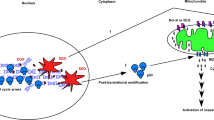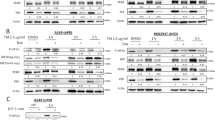Abstract
Cells’ ability to evade cell death and to proliferate post geno-/cell-toxic stresses likely leads to formation of cancer. Activation of p38MAPK and p53 following these stresses helps protect cells against cancer development by initiating apoptosis. The duration of p38MAPK and p53 activation is regulated by the WIP1 phosphatase. BRCA1-IRIS triggers WIP1 expression in a p53-dependent and -independent manner. BRCA1-IRIS triggers the expression and cytoplasmic localization of the mRNA stabilization and translation inducer, HuR, that binds p53 and PPM1D mRNA. Hence, BRCA1-IRIS overexpression inactivates p38MAPK and/or p53 by upregulating WIP1 expression. BRCA1-IRIS abrogation of the homeostatic balance maintained by the p38MAPK–p53–WIP1 pathway suppressed cell death induced by a lethal dose of short-wavelength UV light, and high dosage of etoposide or H2O2, and allowed cells to survive and proliferate post geno-/cell-toxic stresses. This mechanism represents a new link between geno-/cell-toxic stress and aggressive breast cancer formation in p53 wild-type cells.
This is a preview of subscription content, access via your institution
Access options
Subscribe to this journal
Receive 50 print issues and online access
$259.00 per year
only $5.18 per issue
Buy this article
- Purchase on Springer Link
- Instant access to full article PDF
Prices may be subject to local taxes which are calculated during checkout






Similar content being viewed by others
References
Al-Mohanna M, Al-Khalaf H, Al-Yousef N, Aboussekhra A . (2007). The p16INK4a tumor suppressor controls p21WAF1 induction in response to ultraviolet light. Nucleic Acids Res 35: 223–233.
Bulavin D, Phillips C, Nannenga B, Timofeev O, Donehower L, Anderson C et al. (2004). Inactivation of the Wip1 phosphatase inhibits mammary tumorigenesis through p38 MAPK-mediated activation of the p16(Ink4a)-p19(Arf) pathway. Nat Genet 36: 343–350.
Demuth T, Reavie L, Rennert J, Nakada M, Nakada S, Hoelzinger D et al. (2007). MAP-ing glioma invasion: mitogen-activated protein kinase kinase 3 and p38 drive glioma invasion and progression and predict patient survival. Mol Cancer Ther 6: 1212–1222.
Dumaz N, Meek D . (1999). Serine15 phosphorylation stimulates p53 transactivation but does not directly influence interaction with HDM2. EMBO J 18: 7002–7010.
ElShamy WM, Livingston DM . (2004). Identification of BRCA1-IRIS, a BRCA1 locus product. Nat Cell Biol 6: 954–967.
El-Deiry W, Tokino T, Velculescu VE, Levy DB, Parsons R, Trent JM et al. (1993). WAF1, a potential mediator of p53 tumor suppression. Cell 75: 817.
Fiscella M, Zhang H, Fan S, Sakaguchi K, Shen S, Mercer W et al. (1997). Wip1, a novel human protein phosphatase that is induced in response to ionizing radiation in a p53-dependent manner. Proc Natl Acad Sci USA 94: 6048–6053.
Fornace Jr A . (1999). Phosphorylation of human p53 by p38 kinase coordinates N-terminal phosphorylation and apoptosis in response to UV radiation. EMBO J 18: 6845–6854.
Gorospe M . (2003). HuR in the mammalian genotoxic response: post-transcriptional multitasking. Cell Cycle 2: 412–414.
Hammond E, Giaccia A . (2005). The role of p53 in hypoxia-induced apoptosis. Biochem Biophys Res Commun 331: 718–725.
Hao L, ElShamy WM . (2007). BRCA1-IRIS activates cyclin D1 expression in breast cancer cells by downregulating the JNK phosphatase DUSP3/VHR. Int J Cancer 121: 39–46.
Harrison M, Li J, Degenhardt Y, Hoey T, Powers S . (2004). Wip1-deficient mice are resistant to common cancer genes. Trends Mol Med 10: 359–361.
Hasegawa H, Kakuguchi W, Kuroshima T, Kitamura T, Tanaka S, Kitagawa Y et al. (2009). HuR is exported to the cytoplasm in oral cancer cells in a different manner from that of normal cells. Br J Cancer 100: 1943–1948.
Hermeking H, Lengauer C, Polyak K, He TC, Zhang L, Thiagalingam S et al. (1997). 14-3-3 sigma is a p53-regulated inhibitor of G2/M progression. Mol Cell 1: 3.
Hickson JA, Fong B, Watson PH, Watson AJ . (2007). PP2Cdelta (Ppm1d, WIP1), an endogenous inhibitor of p38 MAPK, is regulated along with Trp53 and Cdkn2a following p38 MAPK inhibition during mouse preimplantation development. Mol Reprod Dev 74: 821–834.
Hirasawa A, Saito-Ohara F, Inoue J, Aoki D, Susumu N, Yokoyama T et al. (2003). Association of 17q21-q24 gain in ovarian clear cell adenocarcinomas with poor prognosis and identification of PPM1D and APPBP2 as likely amplification targets. Clin Cancer Res 9: 1995–2004.
Hsieh Y, Wu T, Huang C, Hsieh Y, Hwang J, Liu J . (2007). p38 mitogen-activated protein kinase pathway is involved in protein kinase Calpha-regulated invasion in human hepatocellular carcinoma cells. Cancer Res 67: 4320–4327.
Huang C, Ma WY, Maxiner A, Sun Y, Dong Z . (1999). p38 kinase mediates UV-induced phosphorylation of p53 protein at serine 389. J Biol Chem 274: 12229.
Im JS, Lee JK . (2008). ATR-dependent activation of p38 MAP kinase is responsible for apoptotic cell death in cells depleted of Cdc7. J Biol Chem 283: 25171–25177.
Jin S, Mazzacurati L, Zhu X, Tong T, Song Y, Shujuan S et al. (2003). Gadd45a contributes to p53 stabilization in response to DNA damage. Oncogene 22: 8536.
Junttila M, Ala-Aho R, Jokilehto T, Peltonen J, Kallajoki M, Grenman R et al. (2007). p38alpha and p38delta mitogen-activated protein kinase isoforms regulate invasion and growth of head and neck squamous carcinoma cells. Oncogene 26: 5267–5279.
Kang M, Ryu B, Lee M, Han J, Lee J, Ha T et al. (2008). NF-kappaB activates transcription of the RNA-binding factor HuR, via PI3K-AKT signaling, to promote gastric tumorigenesis. Gastroenterology 135: 2030–2042, 2042.e1-3.
Lafarga V, Cuadrado A, Lopez de Silanes I, Bengoechea R, Fernandez-Capetillo O, Nebreda A . (2009). p38 Mitogen-activated protein kinase- and HuR-dependent stabilization of p21(Cip1) mRNA mediates the G/S checkpoint. Mol Cell Biol 29: 4341–4351.
Latonen L, Laiho M . (2005). Cellular UV damage responses—functions of tumor suppressor p53. Biochim Biophys Acta 1755: 71–89.
Li I, Ke S, Ruiwen C, Yan H, Dan W, Shuhan S . (2007). p53 promoter-based reporter gene in vitro assays for quick assessment of agents with genotoxic potential. Acta Biochim Biophys Sin 39: 181–186.
Licata L, Hostetter C, Crismale J, Sheth A, Keen J . (2009). The RNA-binding protein HuR regulates GATA3 mRNA stability in human breast cancer cell lines. Breast Cancer Res Treat 122: 55–63.
Lim S, Lee S, Joo S, Song J, Choi S . (2009). Cytoplasmic Expression of HuR is Related to Cyclooxygenase-2 Expression in Colon Cancer. Cancer Res Treat 41: 87–92.
Lowe SW . (1999). Activation of p53 by oncogenes. Endocr Relat Cancer 6: 45–48.
Lowe J, Cha H, Yang Q, Fornace Jr A . (2010). Nuclear Factor-κB (NF-κB) Is a Novel Positive Transcriptional Regulator of the Oncogenic Wip1 Phosphatase. J Bio Chem 285: 5249–5257.
Maréchal R, Van Laethem J . (2009). HuR modulates gemcitabine efficacy: new perspectives in pancreatic cancer treatment. Expert Rev Anticancer Ther 9: 1439–1441.
Mazan-Mamczarz K, Galba'n S, Lo'pez de Silanes I, Martindale J, Atasoy A, Keene J et al. (2003). RNA-binding protein HuR enhances p53 translation in response to ultraviolet light irradiation. Proc Natl Acad Sci 100: 8354–8359.
Mikhailov A, Shinohara M, Rieder C . (2004). Topoisomerase II and histone deacetylase inhibitors delay the G2/M transition by triggering the p38 MAPK checkpoint pathway. J Cell Biol 166: 517.
Moll U, Schramm L . (1998). p53—an acrobat in tumorigenesis. Crit Rev Oral Biol Med 9: 23–37.
Nakuci E, Mahner S, Direnzo J, ElShamy WM . (2006). BRCA1-IRIS regulates cyclin D1 expression in breast cancer cells. Exp Cell Res 312: 3120–3131.
Nicholson DW, Thornberry NA . (1997). Caspases: killer proteases. TIBS 22: 299–306.
Reinhardt H, Aslanian A, Lees J, Yaffe M . (2007). p53-deficient cells rely on ATM- and ATR-mediated checkpoint signaling through the p38MAPK/MK2 pathway for survival after DNA damage. Cancer Cell 11: 175.
Rodríguez-Bravo V, Guaita-Esteruelas S, Salvador N, Bachs O, Agell N . (2007). Different S/M checkpoint responses of tumor and non tumor cell lines to DNA replication inhibition. Cancer Res 67: 11648–11656.
Saito-Ohara F, Imoto I, Inoue J, Hosoi H, Nakagawara A, Sugimoto T et al. (2003). PPM1D is a potential target for 17q gain in neuroblastoma. Cancer Res 63: 1876–1883.
Sakuma T, Nakagawa T, Ido K, Takeuchi H, Sato K, Kubota T . (2008). Expression of vascular endothelial growth factor-A and mRNA stability factor HuR in human meningiomas. J Neurooncol 88: 143–155.
She Q, Bode AM, Ma WY, Chen NY, Dong Z . (2001). Resveratrol-induced activation of p53 and apoptosis is mediated by extracellular-signal-regulated protein kinases and p38 kinase. Cancer Res 61: 1604.
Shieh S, Ikeda M, Taya Y, Prives C . (1997). DNA damage-induced phosphorylation of p53 alleviates inhibition by MDM2. Cell 91: 325–334.
Sturgill T . (2008). MAP kinase: it's been longer than fifteen minutes. Biochem Biophys Res Commun 371: 1–4.
Suarez-Cuervo C, Merrell MA, Watson L, Harris KW, Rosenthal EL, Väänänen HK et al. (2004). Breast cancer cells with inhibition of p38alpha have decreased MMP-9 activity and exhibit decreased bone metastasis in mice. Clin Exp Metastasis 21: 525.
Sykes SM, Stanek TJ, Frank A, Murphy ME, McMahon SB . (2009). Acetylation of the DNA binding domain regulates transcription-independent apoptosis by p53. J Biol Chem 284: 20197–20205.
Takekawa M, Adachi M, Nakahata A, Nakayama I, Itoh F, Tsukuda H et al. (2000). p53-inducible Wip1 phosphatase mediates a negative feedback regulation of p38 MAPK-p53 signaling in response to UV radiation. EMBO J 19: 6517–6526.
Tenenbaum SA, Lager P, Carson C, Keene J . (2002). Ribonomics: identifying mRNA subsets in mRNP complexes using antibodies to RNA-binding proteins and genomic arrays. Methods 26: 191–198.
Tong X, Pelling J . (2009). Enhancement of p53 Expression in Keratinocytes by the Bioflavonoid Apigenin is Associated With RNA-Binding Protein HuR. Mol Carc 48: 118–129.
Tran H, Maurer F, Nagamine Y . (2003). Stabilization of urokinase and urokinase receptor mRNAs by HuR is linked to its cytoplasmic accumulation induced by activated mitogen-activated protein kinase-activated protein kinase 2. Mol Cell Biol 23: 7177–7188.
Wang S, El-Deiry WS . (2006). p73 or p53 directly regulates human p53 transcription to maintain cell cycle checkpoints. Cancer Res 66: 6982–6989.
Yamaguchi H, Minopoli G, Demidov O, Chatterjee D, Anderson C, Durell S et al. (2005). Substrate specificity of the human protein phosphatase 2C delta, Wip1. Biochemistry 44: 5285–5294.
Yao KM, Samson ML, Reeves R, White K . (1993). Gene elav of Drosophila melanogaster: a prototype for neuronal-specific RNA binding protein gene family that is conserved in flies and humans. J Neurobiol 24: 723–739.
Acknowledgements
This research was supported in part by a start-up support from the University of Hawaii, and in part by a Grant from the Hawaii Community Foundation to WMeS. Wael M ElShamy is a Dr Lawrence and Mrs Bo Hing Chen Tsue American Cancer Society Scholar.
Author information
Authors and Affiliations
Corresponding author
Ethics declarations
Competing interests
We declare there are not any competing financial interests in relation to the study described. However, Wael M ElShamy has submitted patent application.
Additional information
Supplementary Information accompanies the paper on the Oncogene website
Supplementary information
Rights and permissions
About this article
Cite this article
Chock, K., Allison, J. & ElShamy, W. BRCA1-IRIS overexpression abrogates UV-induced p38MAPK/p53 and promotes proliferation of damaged cells. Oncogene 29, 5274–5285 (2010). https://doi.org/10.1038/onc.2010.262
Received:
Revised:
Accepted:
Published:
Issue Date:
DOI: https://doi.org/10.1038/onc.2010.262
Keywords
This article is cited by
-
Molecular characterization and elucidation of the function of Hap38 MAPK in the response of Helicoverpa armigera (Hübner) to UV-A stress
Scientific Reports (2022)
-
Molecular characterization of two MAPK genes and their thermotolerant functions in a high temperature acclimated strain of Neoseiulus barkeri
BioControl (2022)
-
Premature polyadenylation of MAGI3 is associated with diminished N6-methyladenosine in its large internal exon
Scientific Reports (2018)
-
The role of BRCA1-IRIS in the development and progression of triple negative breast cancers in Egypt: possible link to disease early lesion
BMC Cancer (2017)
-
BRCA1-IRIS inactivation overcomes paclitaxel resistance in triple negative breast cancers
Breast Cancer Research (2015)



